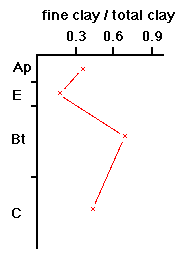The illuvial process is a complex one and is not easy to study. It is often difficult to recognise. As it is a process which is widespread in soils (especially in climates with very dry and wet periods), it has been well researched and there are a wide range of techniques to identify it.
![]() Field methods
Field methods
The translocation of clay particles from one point to another has an important influence on the soil, which can be considered at both a macroscopic and microscopic level. Its most significant macromorphological manifestation is the production of a strong textural change in the profile. The dragging of the clay particles from the surface horizons and their accumulation at a certain depth causes visible changes in colour, texture, structure and consistency. Thus, a profile in which clay illuviation has been very intense shows a typical sequence of A, E and Bt horizons. The eluvial E horizon is discoloured or sometimes clear white, with a sandy texture and fairly undeveloped structures with few cracks of a single grains or massive and sometimes laminar type. On the other hand, the illuvial horizon is brown or red in colour with high chromas, its texture is clayey and it has a highly developed structure with numerous wide cracks with a coarse or prismatic angular blocky type. Unfortunately, the profile of an illuvial soil is often not so demonstrative and it is quite common for the soil to have no E horizon, either because the clay illuviation has not been intense enough to enable the E horizon to be distinguished from the A horizon, or because it is a surface horizon and therefore has a fairly undeveloped structure with a great tendency to erode or, often, simply because of its mixture with the adjacent horizons due to ploughing.
In all these cases, it is essential to carefully observe how the clay is located in the B horizon and look for the possible presence of clayskins on the pore walls and on the surface of the aggregates under the microscope.
The existence of these coatings can in itself prove the development of the illuvial process, as long as they are thick enough to show the necessary morphological features, such as a different colouring to the rest of the pedological matrix, or glossy surface with the grains of sand being covered by the clayskins. Occasionally, it is possible to observe the presence of internal laminations or the existence of a clear boundary which distinguishes them from the rest of the surrounding pedological material. Their location on the surface of aggregates or covering the walls of the macropores are features of great diagnostic value which allow them to be distinguished from their "great enemies" in the field, such as pressure faces (slickensides).
![]() Textural analysis
Textural analysis
The detailed granulometric analysis of the clay fraction is based on the fact that the smaller the size of the clay, the easier it is for it to be mobilised. For this reason, ratio fine to total clay may be used as a diagnostic criterium, as it is to be expected that this reaches higher values in the Bt horizons than in the eluvial horizons.

In any case, this method is not conclusive on its own because, as indicated previously, in conditions of soil evolution, the minerals of neoformation tend to crystalize in very small grain sizes.
![]() Micromorphological methods
Micromorphological methods
Micromorphology is the best technique for identifying and studying the clay illuviation process.
Identification of clay illuviation
In general, it is not easy to judge whether a particular oriented clay domain is illuvial or not, but the microscope is perhaps the main tool to be used in the identification of clay illuviation. The characteristics by which the illuvial origin of the clay are recognised in a thin section are: optic continuity, a strongly preferential orientation, an intense interference colour, the existence of laminations, a textural contrast with the adjacent matrix, an abrupt boundary with the surrounding material (both under parallel and crossed nicols, its own natural colour, and coating of the walls of the macropores or the surfaces of the aggregates.
Sometimes it is very easy and sometimes it is very difficult.
Bt horizon with a sandy texture that is very easy to recognize from the illuviation of clay
Bt horizon of loamy texture of easy recognition of the illuviation of the clay
Bt horizon with clayey texture of moderately easy recognition of illuviation from clay
Bt horizon with a clayey texture difficult to recognize from the illuviation of the clay
Horizon Bt or Bw?